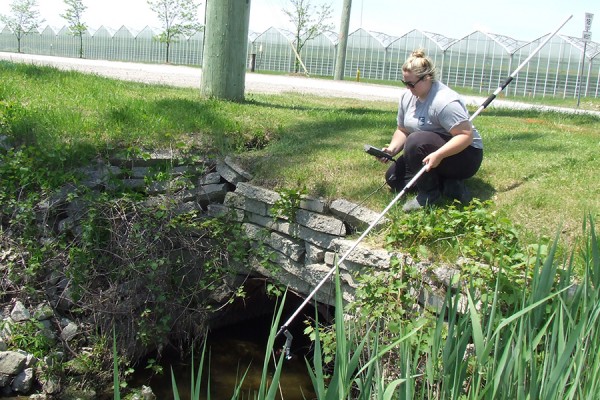 Mackenzie Porter of the Essex Region Conservation Authority measures water quality in a waterway adjacent to a greenhouse operation.
Mackenzie Porter of the Essex Region Conservation Authority measures water quality in a waterway adjacent to a greenhouse operation.
A collaborative study by the Great Lakes Institute for Environmental Research (GLIER), the Essex Region Conservation Authority (ERCA), and Ryerson University shows Essex County greenhouses might be producing a significant amount of nutrient-rich runoff relative to other types of agriculture.
Higher concentrations of nutrients such as nitrogen and phosphorus in the watersheds can contribute to the growth of harmful algae blooms in Lake Erie. Toxins produced by the algae prevented residents on Pelee Island from being able to drink water from their wells in the summer, and were responsible for a tap water shutdown in Toledo, Ohio, in 2014. The Great Lakes Water Quality Agreement calls for a 40 per cent reduction in these nutrients in order to minimize the risks caused by the algae blooms.
ERCA collected five years of water samples from 14 Essex County rivers in agriculturally-dominated watersheds in southwestern Ontario, with nine of the watersheds influenced by local greenhouses. The study found greenhouse influenced rivers were four to 28 times higher in nutrient concentrations, compared to non-influenced rivers. The concentrations did show a decreasing trend during the five-year study, which also accounted for environmental variables such as precipitation.
“These numbers aren’t surprising; the significance of this study is having quality data available in an accessible, peer-reviewed paper, so we can now work with governmental regulatory bodies, the greenhouse sector and others to make changes that will help reduce nutrient runoff,” says Katie Stammler, water quality scientist with ERCA.
“It is important to note that the Ontario’s greenhouse operators are already making significant changes by voluntarily adopting innovative best management practices to reduce the release of phosphorus and are also working to comply with new regulatory requirements.”
Dr. Stammler says this highlights the need for long-term monitoring of nutrients, river flows and collecting weather data in assessing these agricultural sectors.
“Technologies do exist, and need to be implemented, to ameliorate the nutrient loads of greenhouses, which will require cooperation between growers and regulators to ensure the vitality of the sector while limiting pollution in the watershed,” she says.
Scott Mundle, chemistry and biochemistry professor and GLIER researcher, says this is a mutually beneficial partnership.
“ERCA has world-class expertise focused on monitoring and collecting valuable data throughout the watershed. Academic researchers often don’t have the resources or funding to collect large, comprehensive, high quality datasets over a significant number of years,” says Dr. Mundle.
“Now we have a peer-reviewed study in a leading environmental journal that will help in the development of regulatory guidelines targeting nutrient sources on regional scales.”
ERCA started collecting the samples in 2012, after a 2011 study conducted by the Ministry of the Environment and Climate Change found elevated nutrient levels in greenhouse influenced streams in the Essex Region.
Stammler says the Great Lakes Water Quality Agreement requires a reduction in load, and not concentration of nutrients, since load is what influences severity and size of algae blooms in Lake Erie.
“Our study monitored concentrations of nutrients, not load, so we’ve ramped up monitoring for the next step in the process, to calculate loads and understand how these inputs compare to other recognized sources in the Great Lakes.”
Tim Maguire, a UWindsor postdoctoral researcher in Mundle’s lab, was lead author on the collaboration with Stammler and Chris Wellen from Ryerson University. They published their paper, Increased Nutrient concentrations in Lake Erie tributaries influenced by greenhouse agriculture, in the journal Science of the Total Environment.
“The greenhouse sector is going to continue to grow and we need to work together to help develop strategies that minimize the environmental footprint of these important agricultural and industrial sectors in the region,” Mundle says.
This project has received funding support from the Government of Ontario. Such support does not indicate endorsement by the Government of Ontario of the contents of this material.
Sara Elliott
